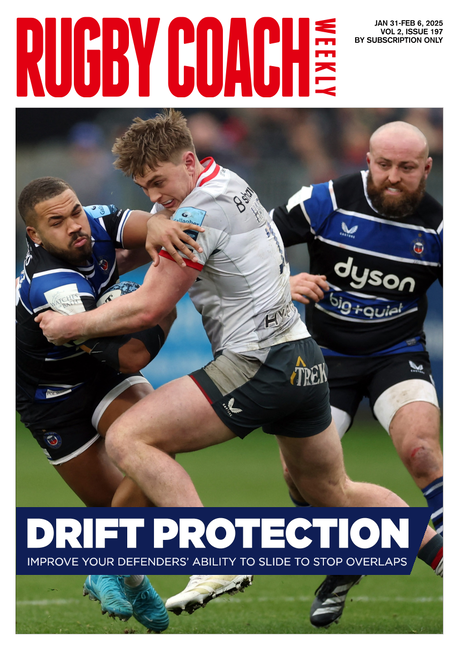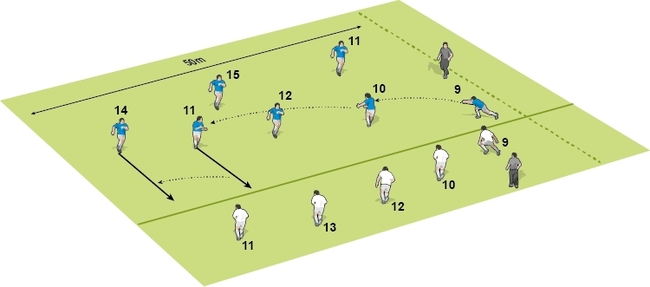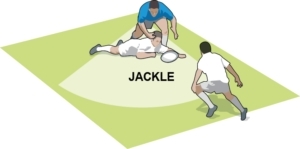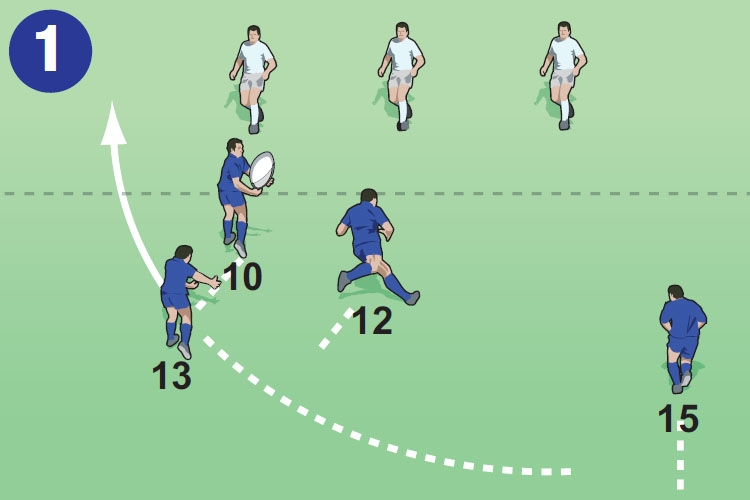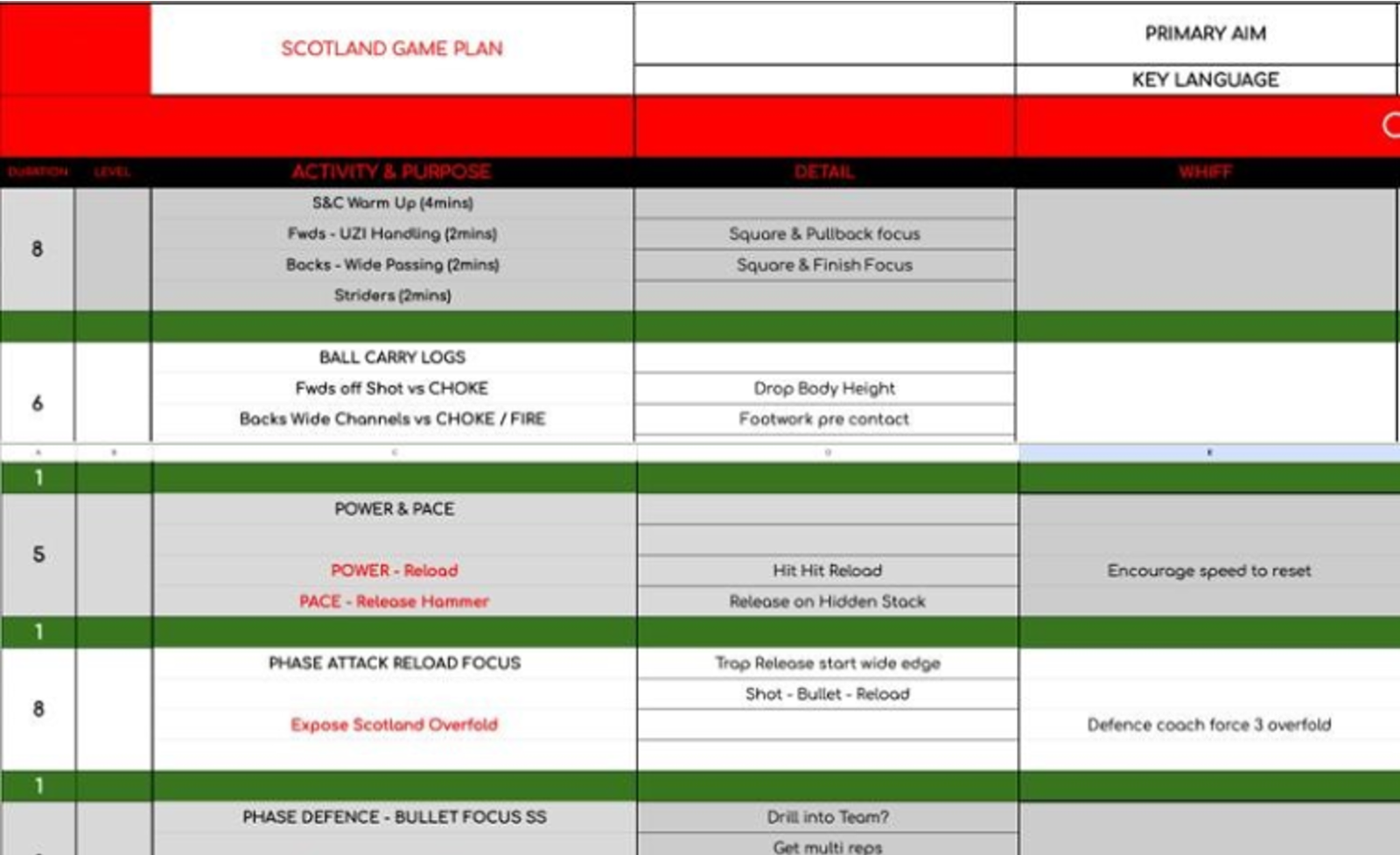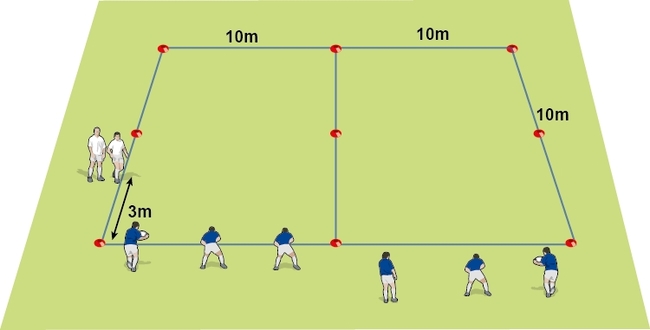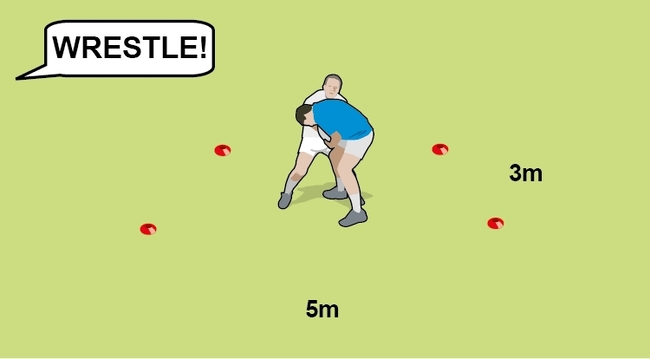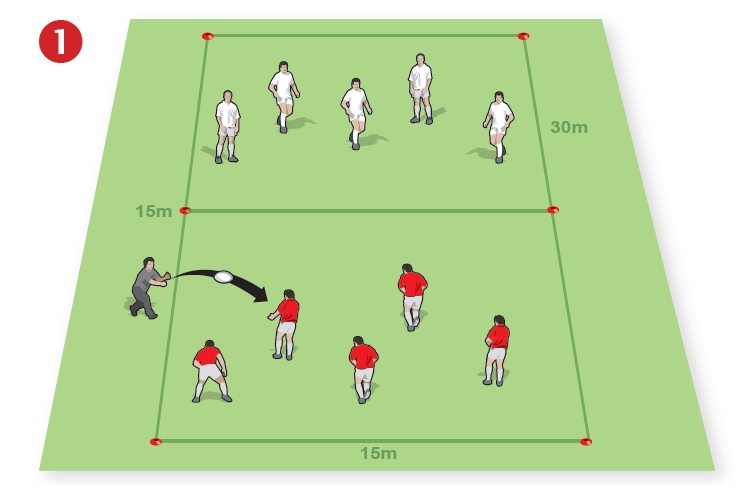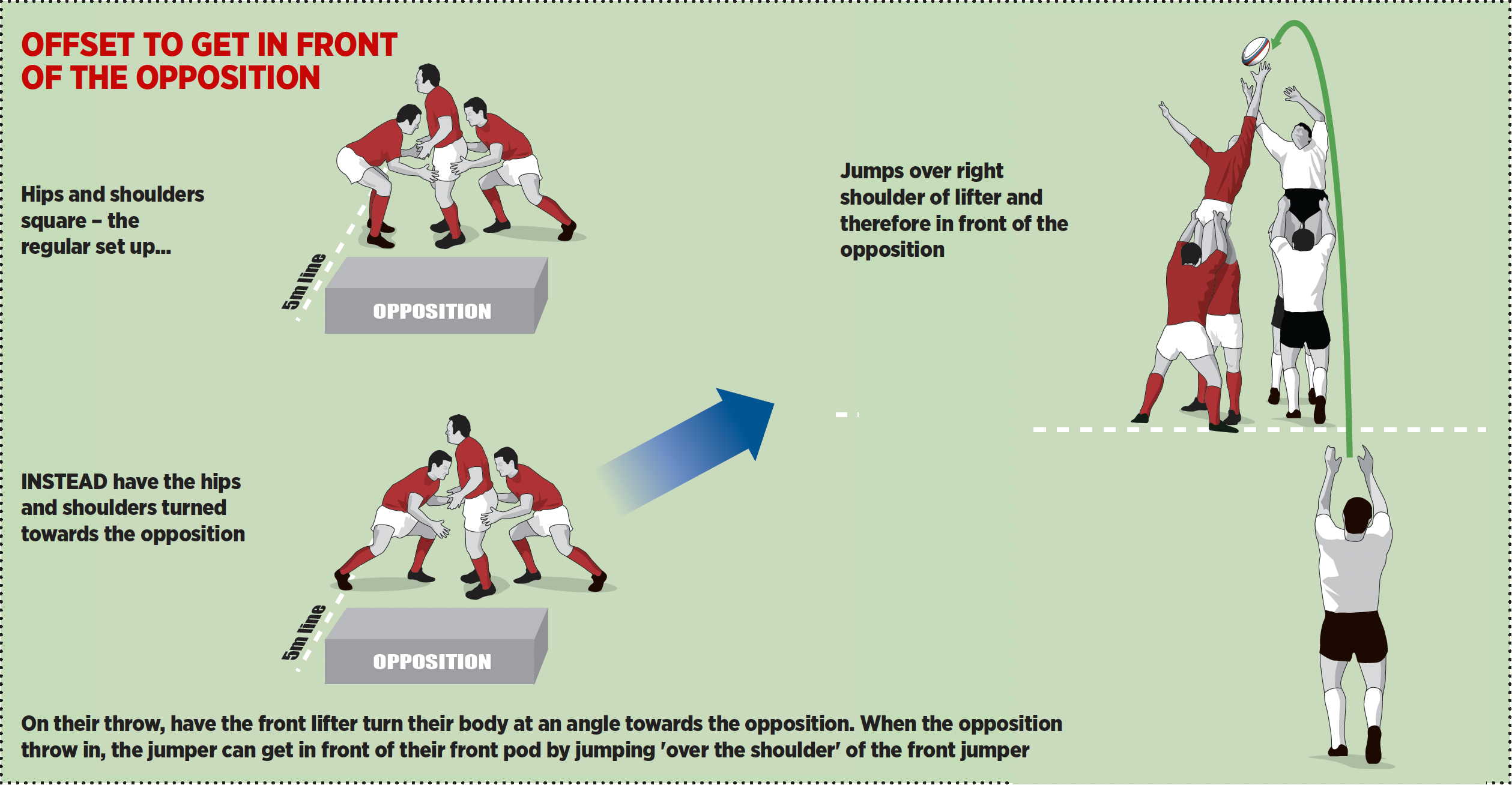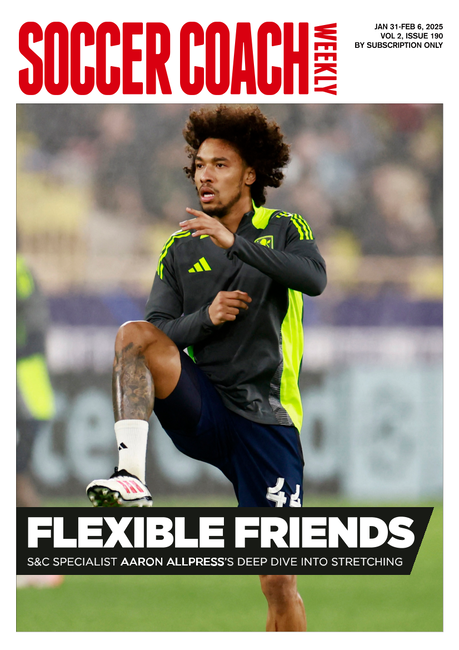Expert principles of defence
Tacticsby Andrew Strawbridge
You need to be flexible in your approach to backline defence and suit the strengths of the team you coach. But there are principles you need to keep to be effective in the modern game.

I have coached a number of different teams and I think it is important not to impose a particular pattern, defensive or attacking, on any team. I prefer to work through a process with the players that suits their strengths.
In training, we will run plenty of attacking moves against the backline to develop our ideas. We are also working on our counter-attacking options from a defensive point of view.
Here are my main themes for all areas of the pitch and then specific plans for their and own 22m area. For instance, if they have a scrum in their 22m area, then we might send up a couple of fliers. In our 22m area, our wingers will be further up.
From all set-piece, the backline starts from 7, the openside flanker. This is equally applicable from lineout or scrum.
We want 7 to be very tight to 10, the fly-half. What 10 does in terms of how he pushes out depends on how the 7 comes out of the set-piece. 10 cannot move out onto another player on a drift if 7 is slowed down.
At the lineout, 10 starts inside the opposition 10. With the 20 metre gap from a lineout and a 15 metre gap at the scrum, the channel between 7 and 10 is vital. 10 must hold his space.
Even if the 10 is not a great tackler, he should be a presence. We would make sure that 12 would cover this tackle if necessary.
It is a race for space. 12 and 13 will work off 10’s push. So if 10 has to stay in because 7 is struggling, then 12 and 13 will stay in. Outside 12 and 13, our openside winger will choose his positioning based on the field position.
In our 22m he will move up to be the third centre. In their 22m, he will be back for the kick. If they run, then he will join the line on an arc. This will mean that he balances his run so that he joins from an inside out position, joining the outside centre (13) as he pushes out.
In defence, especially with the positioning of the wingers, we want to tell attacking teams: “Don’t kick here!” This information will be fed through to their 9 or 10. However, we can suddenly change our positioning and trick them into kicking into the spaces.
For instance, we might push up our openside winger into the backline. As the ball is thrown in, he drops back to cover the possible kick. The attack might have decided not to run the ball open, and either kick or drive the ball up the middle.
We need to encourage players to feedback in our defensive training. We run backline against backline. When the attackers have run a move, they need to say how they felt the defence did.
It works both ways. Both attack and defence can offer ways to improve. Deception lines might be adjusted, tackle technique might be more solid.
In the early stages of the defence training, the attackers can provide vital information on the strength in the tackle. Did it knock them off their feet, did they feel under pressure, how easy was it to get the pass away?
If the attacker can provide this feedback constructively he is, in fact, improving his own understanding of the tackle. He has to understand the principles of defence to be able to make good judgements on, say, foot or shoulder positions.
Open field tackles can mean that the players are leaving their feet to make the tackle. However, the best tackle has the player maintaining his feet. Forwards especially might find themselves exposed. Therefore we need to train for this type of tackle.
To improve this technique we work on 2 v 2s. Players have to use their angles to cover the ball carrier.
Cutting across the bows
In a 2 v 2 defensive situation, it is important that the nearest defender not involved in the tackle moves quickly to compete for the ball. Often, in a drift defence, this is the defender who was marking the previous ball carrier. He needs to win the "race for space", perhaps even "cutting across the bows" of the player he was marking.
In all defence work, players need to work on the following principles:
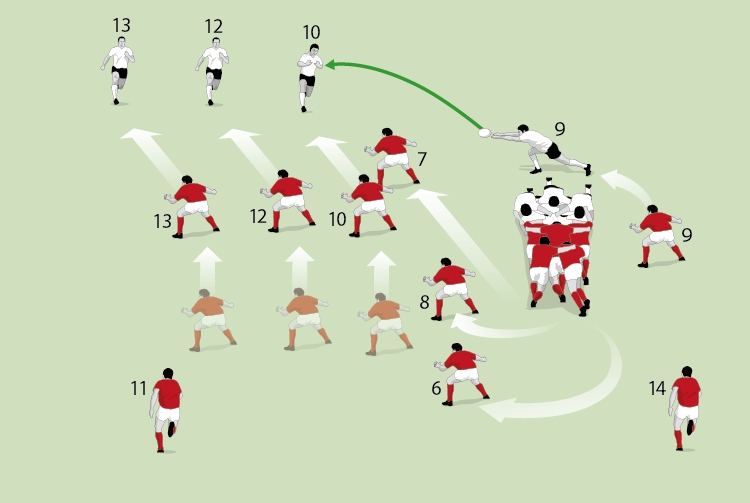
Defending from a square scrum: defensive roles: 7 keeps tight to 10, 8 covers in behind 7, 6 covers behind, 9 marks 9
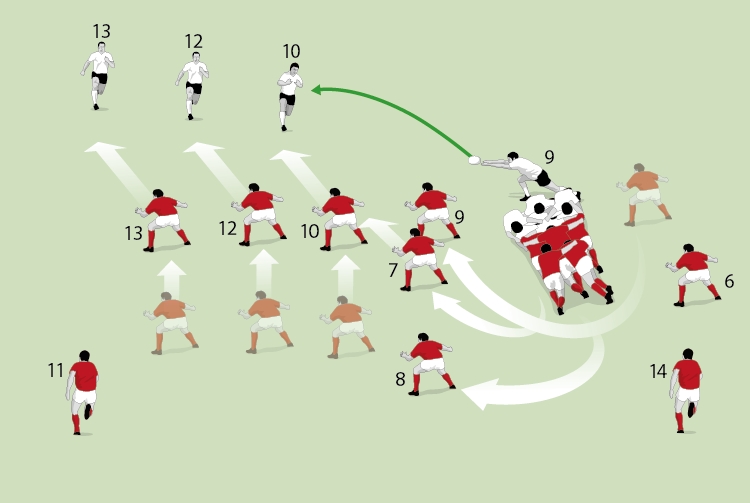
Defending from a wheeled scrum: defensive roles: 9 moves around the other side of the scrum and takes on 7's role from a normal scrum, 7 takes on the role of 8, 8 takes on the role of 6, 6 guards the blindside
It is possible that the scrum is wheeled the wrong way. On the left-hand side of the field, this would be where their tight head moves up on our loose-head.
This moves our 7 further back from their 10. If this happens, 9 now takes on the role of 7, and 7 operates like an 8 and 8 acts like 9 would. 9 chases down their 10.
7 aims to be second to the breakdown. 8 might have to sweep behind the defensive line, his depth dependent on the field position.

COACH THE TEAM, NOT THE SYSTEM
I have coached a number of different teams and I think it is important not to impose a particular pattern, defensive or attacking, on any team. I prefer to work through a process with the players that suits their strengths.
In training, we will run plenty of attacking moves against the backline to develop our ideas. We are also working on our counter-attacking options from a defensive point of view.
MAIN THEMES AND SPECIFIC DEFENSIVE PLANS
Here are my main themes for all areas of the pitch and then specific plans for their and own 22m area. For instance, if they have a scrum in their 22m area, then we might send up a couple of fliers. In our 22m area, our wingers will be further up.
From all set-piece, the backline starts from 7, the openside flanker. This is equally applicable from lineout or scrum.
We want 7 to be very tight to 10, the fly-half. What 10 does in terms of how he pushes out depends on how the 7 comes out of the set-piece. 10 cannot move out onto another player on a drift if 7 is slowed down.
SETTING UP THE BACKS
At the lineout, 10 starts inside the opposition 10. With the 20 metre gap from a lineout and a 15 metre gap at the scrum, the channel between 7 and 10 is vital. 10 must hold his space.
Even if the 10 is not a great tackler, he should be a presence. We would make sure that 12 would cover this tackle if necessary.
It is a race for space. 12 and 13 will work off 10’s push. So if 10 has to stay in because 7 is struggling, then 12 and 13 will stay in. Outside 12 and 13, our openside winger will choose his positioning based on the field position.
In our 22m he will move up to be the third centre. In their 22m, he will be back for the kick. If they run, then he will join the line on an arc. This will mean that he balances his run so that he joins from an inside out position, joining the outside centre (13) as he pushes out.
PAINTING PICTURES
In defence, especially with the positioning of the wingers, we want to tell attacking teams: “Don’t kick here!” This information will be fed through to their 9 or 10. However, we can suddenly change our positioning and trick them into kicking into the spaces.
For instance, we might push up our openside winger into the backline. As the ball is thrown in, he drops back to cover the possible kick. The attack might have decided not to run the ball open, and either kick or drive the ball up the middle.
TRAINING NEEDS FEEDBACK
We need to encourage players to feedback in our defensive training. We run backline against backline. When the attackers have run a move, they need to say how they felt the defence did.
It works both ways. Both attack and defence can offer ways to improve. Deception lines might be adjusted, tackle technique might be more solid.
In the early stages of the defence training, the attackers can provide vital information on the strength in the tackle. Did it knock them off their feet, did they feel under pressure, how easy was it to get the pass away?
If the attacker can provide this feedback constructively he is, in fact, improving his own understanding of the tackle. He has to understand the principles of defence to be able to make good judgements on, say, foot or shoulder positions.
LEAVING THEIR FEET
Open field tackles can mean that the players are leaving their feet to make the tackle. However, the best tackle has the player maintaining his feet. Forwards especially might find themselves exposed. Therefore we need to train for this type of tackle.
To improve this technique we work on 2 v 2s. Players have to use their angles to cover the ball carrier.
Cutting across the bows

In a 2 v 2 defensive situation, it is important that the nearest defender not involved in the tackle moves quickly to compete for the ball. Often, in a drift defence, this is the defender who was marking the previous ball carrier. He needs to win the "race for space", perhaps even "cutting across the bows" of the player he was marking.
In all defence work, players need to work on the following principles:
- The hips need to be facing in the direction of the attacker.
- The defender needs to keep his feet alive. Players should keep themselves on the balls of their feet, so not plant and not get knocked on their heels.
DEFENDING FROM A POOR SCRUM

Defending from a square scrum: defensive roles: 7 keeps tight to 10, 8 covers in behind 7, 6 covers behind, 9 marks 9

Defending from a wheeled scrum: defensive roles: 9 moves around the other side of the scrum and takes on 7's role from a normal scrum, 7 takes on the role of 8, 8 takes on the role of 6, 6 guards the blindside
It is possible that the scrum is wheeled the wrong way. On the left-hand side of the field, this would be where their tight head moves up on our loose-head.
This moves our 7 further back from their 10. If this happens, 9 now takes on the role of 7, and 7 operates like an 8 and 8 acts like 9 would. 9 chases down their 10.
7 aims to be second to the breakdown. 8 might have to sweep behind the defensive line, his depth dependent on the field position.
Newsletter Sign Up
Coaches Testimonials

Gerald Kearney, Downtown Las Vegas Soccer Club

Paul Butler, Florida, USA

Rick Shields, Springboro, USA

Tony Green, Pierrefonds Titans, Quebec, Canada
Subscribe Today
Be a more effective, more successful rugby coach
In a recent survey 89% of subscribers said Rugby Coach Weekly makes them more confident, 91% said Rugby Coach Weekly makes them a more effective coach and 93% said Rugby Coach Weekly makes them more inspired.
Get Weekly Inspiration
All the latest techniques and approaches
Rugby Coach Weekly offers proven and easy to use rugby drills, coaching sessions, practice plans, small-sided games, warm-ups, training tips and advice.
We've been at the cutting edge of rugby coaching since we launched in 2005, creating resources for the grassroots youth coach, following best practice from around the world and insights from the professional game.

